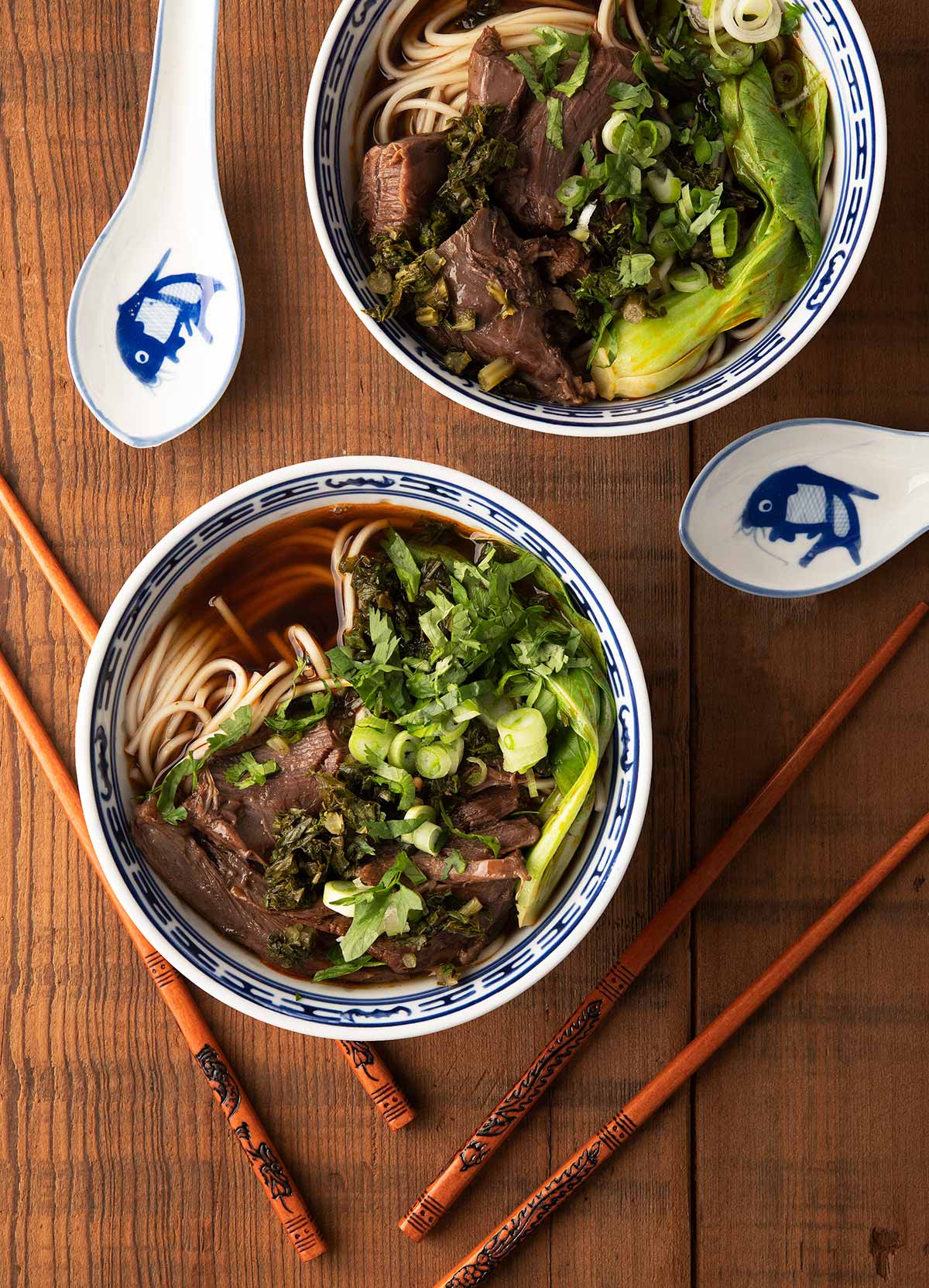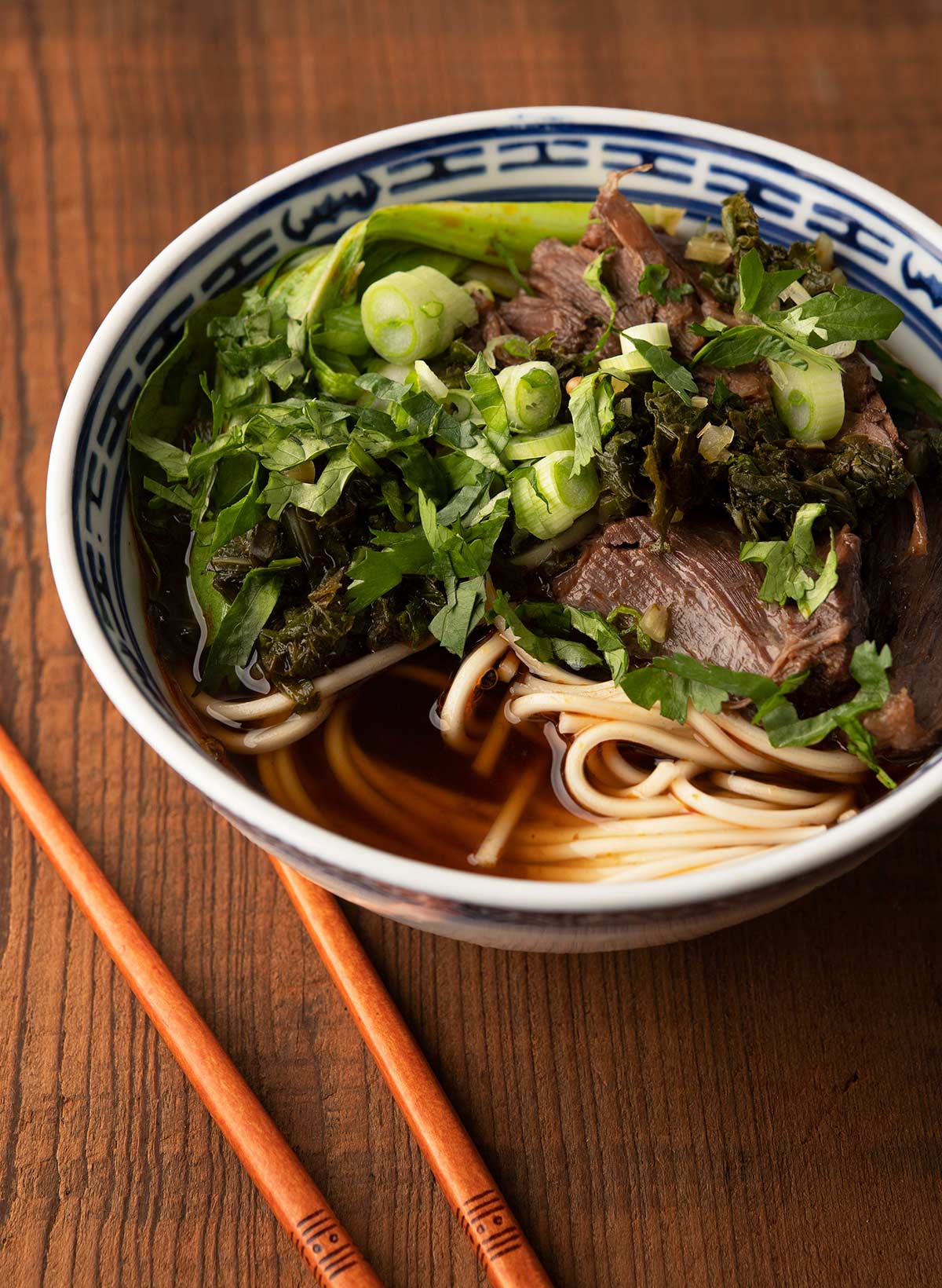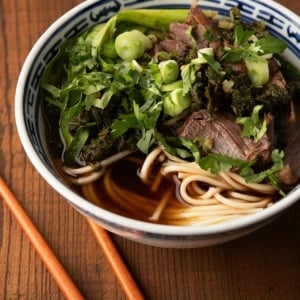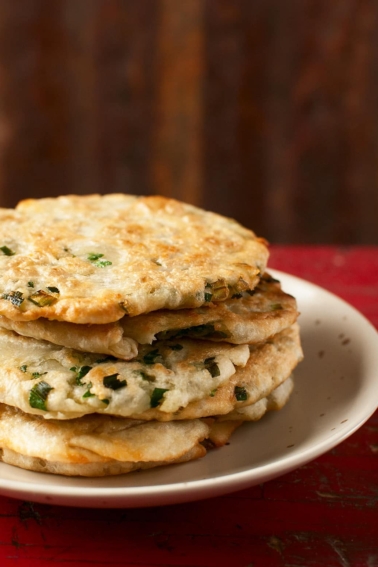As an Amazon Associate I earn from qualifying purchases.
Taiwanese beef noodle soup is serious Asian comfort food. It’s made with shanks, beef in most cases, but I’m using venison here. Pork, lamb or bear would be OK as well. Why shanks? In a word, silk.
Using shanks for this soup makes the broth extra silky, thicker than water, with body and a certain slickness you can only get from collagen. And shanks are loaded with collagen.

Over the years, I’ve been building a library of excellent venison shank recipes, and I wanted one from Asia. So I started looking around, and found Taiwanese beef noodle soup.
It makes sense to use shanks in this soup because of that collagen, but you could also use shoulder or neck meat. If you are using beef, shanks are easily found in Asian markets, and I see them a lot in regular supermarkets, too. Veal shanks are even better if you can find them.
At its core, Taiwanese beef noodle soup is that broth, plus chunks of shank meat, lots of Chinese wheat noodles, some baby bok choy or something similar, and lots of chopped herbs like cilantro and green onions.
One esoteric item that is almost always added is fermented greens, sort of like sauerkraut. I have a great recipe for Chinese pickled mustard greens here, but you can skip this and the soup will still be great.
It is street food, something to order on a cool, rainy day to slurp down to keep warm. That said, it’s just as good as a Sunday supper, and, once you make the broth, it will keep for a week in the fridge.

A word on the noodles. Actual Chinese noodles make a difference. They are paler and chewier than spaghetti, which would be a reasonable substitute. You can obviously find them at Asian markets, but in many cases you will see these noodles in the Asian section of regular markets. Ramen noodles are similar and will work, too. Or, you can make your own.
If you are familiar with “red cooked” dishes, like red cooked pork, it is a braise made with spices, cooking wine and soy sauce. This is basically that, but thin enough to be a broth. Taiwanese beef noodle soup is much darker and richer than Vietnamese pho, but they eat similarly: Chopsticks in one hand, spoon in the other. Slurp some noodles, ideally wrapped around a piece of tender shank and some herbs, then a spoonful of broth.
The way to eat this all week is to have lots of broth and shanks cooked, on, say, a Sunday. Then, when you want to eat some soup, all you need to do is heat the broth and meat, boil some noodles and top with the vegetables and herbs. And, like most braises, Taiwanese beef noodle soup is indeed better a day or three after it’s made.
There are lots of versions of this soup, and to make this recipe I read several dozen, both online and in my collection of Chinese cookbooks. That said, I am indebted to Hsiao Ching-Chao’s Chinese Soul Food. Her recipe is excellent, and I can highly recommend her book.
Taiwanese Beef Noodle Soup
Ingredients
- 2 deer shanks, or 3 to 4 pounds of similar shank meat
- 3 tablespoons lard or peanut oil
- 6 to 8 green onions, divided
- 6 cloves garlic, peeled and smashed
- A 4-inch long piece of ginger, peeled and sliced thinly
- 4 star anise pods (optional)
- 1 heaping teaspoon Sichuan peppercorns (optional)
- 2 to 6 dried hot chiles, broken and seeded
- 1 cup Shaoxing wine, or dry sherry
- 1 cup soy sauce
- 1/4 cup Chinese black bean sauce
- 1 tablespoon sorghum syrup or dark honey (optional)
- 2 pounds Chinese wheat noodles (see Headnotes)
- 4 baby bok choy heads, leaves separated
- 1/2 cup chopped cilantro
- 1 cup chopped pickled mustard greens (optional)
Instructions
- Submerge the shanks in water in a large soup pot. Bring this to a boil and let it roll for a couple minutes. Remove the shanks and toss the water. This process removes some of the scum that floats to the surface, and will make a cleaner tasting, clearer broth.
- While you are waiting for this to happen, chop all your vegetables. Separate the white parts from the green parts of the green onions. Leave the white parts in large pieces, but finely chop the green parts.
- Wipe the pot out and heat up the lard or oil over medium high heat. Sauté the white parts of the green onions, the garlic and ginger for about 1 minute. Add the star anise, Sichuan peppercorns and chiles and stir to combine. Return the shanks to the pot.
- Pour in the Shaoxing wine, soy sauce, sorghum syrup (or honey) and bean sauce, then enough water to cover everything by about 1 inch. Bring this to a simmer, cover the pot and cook gently until the shanks are tender -- about 2 hours for beef, up to 4 hours for a very old deer or moose or elk or whatever.
- When the shanks are tender, fish them out. While they are cooling, strain the broth. Pull the meat off the bones and cut it into largish chunks. Discard the bones and any weird, vein-y looking things. Wipe the pot again, then pour in the strained broth and add the shank meat to keep warm. Taste it for salt and add some if needed.
- Bring a large pot of water to a boil, salt it, then add the bok choy. Boil the bok choy for about 2 minutes, then remove. Add the noodles.
- To serve, when the noodles are done, put some in everyone's bowls. Top with broth and meat, then add some bok choy, the green parts of the chopped green onions, cilantro, and pickled mustard greens. Some people like a bit more heat, so if you have Chinese chile sauce handy, have that at the table.
Nutrition
Nutrition information is automatically calculated, so should only be used as an approximation.





Made this last night, good recipe. A couple of thoughts, I would add 1/2 the soy sauce up front then when the braise is done add more to taste, 1 cup of soy sauce is a lot of salt. Daikon radish and carrot are good veg to add to this.
I’ve had this recipe bookmarked for a while, and saved shanks from my deer this year specifically for this. I might never use shanks for burger again. When I say this was delicious, I mean I don’t think I’ve ever had a better meal in any restaurant. I did have to make a couple of adjustments, using a chile paste instead of peppercorns and dried chiles, and pickled red cabbage as a substitute for pickled mustard greens (this did NOT disappoint). This will go into our rotation of favorite venison recipes, and I will have to start stocking up on canned ingredients in advance whenever I find myself in an Asian market.
Any estimate on the amount of water, in cups?
Stefan: Just an estimate, but I’d say 6 to 8 cups.
Thank You!! Cooking now. Smells Great! Didn’t have black bean paste; used dobanjiang instead. Hope it works out!
Damn, Hank! That is fantastic! I am glad I still have a few more shanks in the freezer!
Could this be made in a crockpot?
This has changed shanks for me. I never want to use them for anything besides this soup, it was incredible! This makes the meat fall apart tender. I used lamb shanks and was very glad I followed your initial boil then replace the water step because it was so scummy right away and that really did make it a better tasting soup. Thanks!
This was great. I “cheated” with frozen beef shank stock I’d put up a ways back plus a little reduced veal stock to get similar silkiness. And used packaged Zha Cai instead of homemade pickled mustard. The spice and paste blend you recommended really made the soup a complete main course, excellent.
My OH my! Once again Hank crushes it! I used a large Dutch oven and it was amazing. I will do this again. It took about 6 hours. I used a lot of shanks!!!
Will make this weekend. What about dark agave syrup as a sub for the dark honey? Or maple syrup? Have both!
Diana: Definitely not maple. Maybe try the dark agave.
We used fennel and black pepper corns as we are very remote..nearest Asian market 350 miles. I added some hoisin sauce for sweetness,and then some dark honey,as I had estimated too much crushed red pepper (another pantry failure).This was the best shank recipe I have ever found by far,even better than the pulled bbq I think was Hank’s.? The quick boil was a great tip,it did give a fantastic broth. I had used bacon grease instead of lard,so I cooled it and skimmed the fat off as well. Anyway,thank you for the inspiration,brought me back to traveling in my 20s.
Can molasses be substituted for the sorghum syrup? Or regular honey as opposed to dark?
Anthony: I’d just use dark brown sugar in this case.
If you have tendons (they can often be found at the butcher at Chinese markets), and don’t mind the texture (not everyone likes it), it’s often great braised with the shanks and helps thicken the broth even more. The beef shanks are also great shredded/sliced and eaten rolled up inside a scallion pancake.
Im confused…what is wipe the pot? Do you take everything out and dry it–saute the vegetables and return the water and shanks?
Basically I am saving you the full washing step. So yeah, bring the shanks to a boil, remove them and toss the water. Wipe it out with a paper towel and proceed. No need to scrub the pot in between those steps.
Wow, can’t wait to try this one. I’ve been wondering what else I can do with my venison shanks, besides use them in stews or barbacoa and I’ve been a huge fan of Taiwanese beef noodle soup since my first bowl 30 years ago. The five-star anise and Sichuan pepper corns are really nice ideas, though I associate the latter with Chinese cuisine more than Taiwanese fare. My mouth is watering and, just by chance, I have shanks to work with today! Thanks
Hank,
That is one great soup recipe!
Will try this weekend.
Thanks
Tad
I can’t wait to try this. I moved away from my favorite Taiwanese noodle shop and I have withdraws
I love all of Hank’s recipes, but especially those for the less popular cuts. These have allowed me to open many of my friends eyes.
Okay, here’s an ignorant (but eager to learn) question: What’s a shank? A leg, right?
Ellen: It’s the equivalent of your calf. It’s the second to last section of a four footed animal’s leg, between the trotter/foot and the shoulder/thigh.
Beautiful!Just beautiful! Thanks Dennis.